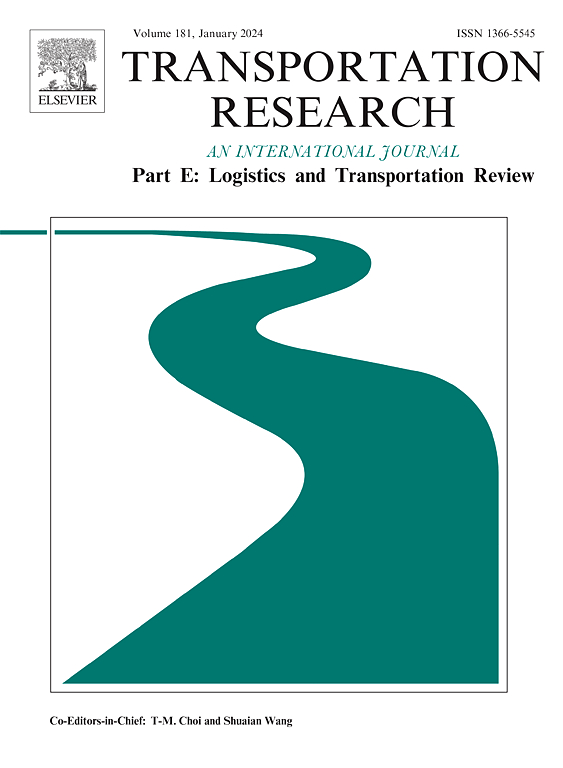Geopolitical disruptions in global supply chains: The role of strategic alliances
IF 8.8
1区 工程技术
Q1 ECONOMICS
Transportation Research Part E-Logistics and Transportation Review
Pub Date : 2025-10-07
DOI:10.1016/j.tre.2025.104448
引用次数: 0
Abstract
Recent geopolitical disruptions, such as tariff surges, trade sanctions, and regulatory fragmentation, have introduced significant uncertainty into global supply chain network design. In this paper, we investigate how firms can leverage strategic alliances as a risk mitigation mechanism in response to two prominent forms of trade restrictions: (i) direct tariff impositions and (ii) quota-based trade barriers. We propose a two-stage robust optimization framework that models strategic alliances as an exogenous parameter, capturing their influence on trade costs and operational flexibility. The framework integrates long-term decisions, such as facility location and capacity planning, with short-term allocation decisions under uncertainty. To reflect realistic service-level obligations often present in global contracts, we also introduce a demand commitment constraint, requiring that a minimum fraction of customer demand be fulfilled across markets. We develop two tractable models: (i) a mixed-integer linear programming (MILP) reformulation for tariff-driven disruptions, and (ii) a two-stage robust model tailored to quota constraints, which are more complex. Using both hypothetical and real-world data, our results demonstrate that strategic alliance structures significantly improve worst-case profitability, particularly in high-uncertainty environments. Remarkably, even a single strategic alliance between a pair of countries can lead to approximately a 50% improvement in worst-case profitability. These findings highlight the value of incorporating strategic alliances into global supply chain network design.
全球供应链中的地缘政治中断:战略联盟的作用
最近的地缘政治动荡,如关税激增、贸易制裁和监管碎片化,给全球供应链网络设计带来了巨大的不确定性。在本文中,我们研究了企业如何利用战略联盟作为风险缓解机制来应对两种主要形式的贸易限制:(i)直接关税征收和(ii)基于配额的贸易壁垒。我们提出了一个两阶段的稳健优化框架,将战略联盟作为外生参数建模,捕捉其对贸易成本和运营灵活性的影响。该框架将设施选址和能力规划等长期决策与不确定情况下的短期分配决策相结合。为了反映全球契约中经常出现的实际服务水平义务,我们还引入了需求承诺约束,要求在各个市场中满足客户需求的最小部分。我们开发了两个易于处理的模型:(i)针对关税驱动中断的混合整数线性规划(MILP)重新公式,以及(ii)针对更复杂的配额约束量身定制的两阶段鲁棒模型。使用假设和现实数据,我们的研究结果表明,战略联盟结构显著提高了最坏情况下的盈利能力,特别是在高不确定性环境中。值得注意的是,即使是两个国家之间的单一战略联盟也可以使最坏情况下的盈利能力提高约50%。这些发现突出了将战略联盟纳入全球供应链网络设计的价值。
本文章由计算机程序翻译,如有差异,请以英文原文为准。
求助全文
约1分钟内获得全文
求助全文
来源期刊
CiteScore
16.20
自引率
16.00%
发文量
285
审稿时长
62 days
期刊介绍:
Transportation Research Part E: Logistics and Transportation Review is a reputable journal that publishes high-quality articles covering a wide range of topics in the field of logistics and transportation research. The journal welcomes submissions on various subjects, including transport economics, transport infrastructure and investment appraisal, evaluation of public policies related to transportation, empirical and analytical studies of logistics management practices and performance, logistics and operations models, and logistics and supply chain management.
Part E aims to provide informative and well-researched articles that contribute to the understanding and advancement of the field. The content of the journal is complementary to other prestigious journals in transportation research, such as Transportation Research Part A: Policy and Practice, Part B: Methodological, Part C: Emerging Technologies, Part D: Transport and Environment, and Part F: Traffic Psychology and Behaviour. Together, these journals form a comprehensive and cohesive reference for current research in transportation science.

 求助内容:
求助内容: 应助结果提醒方式:
应助结果提醒方式:


